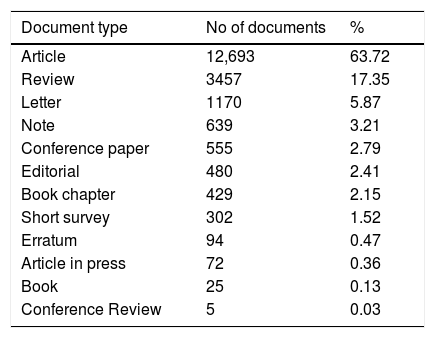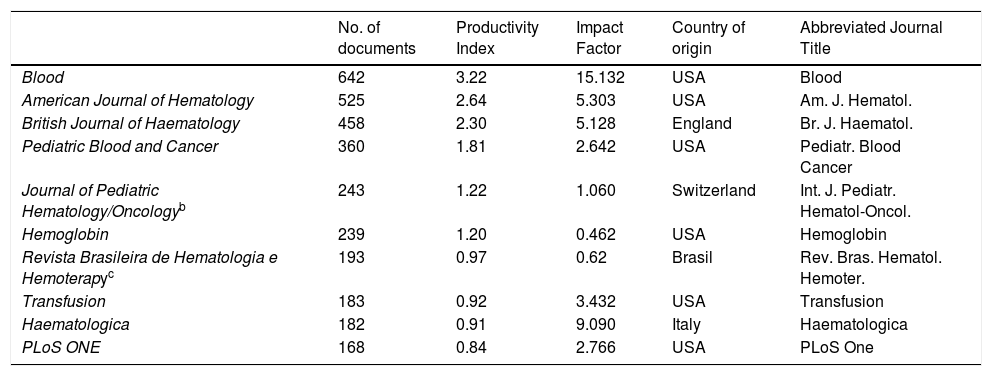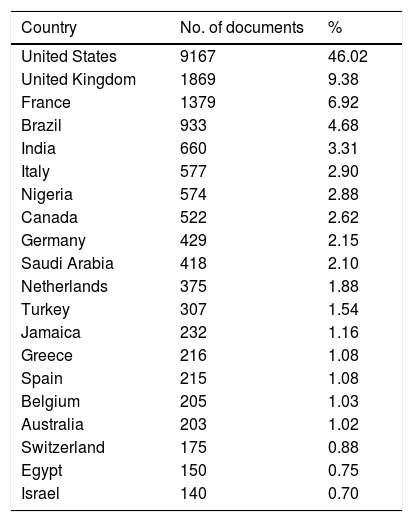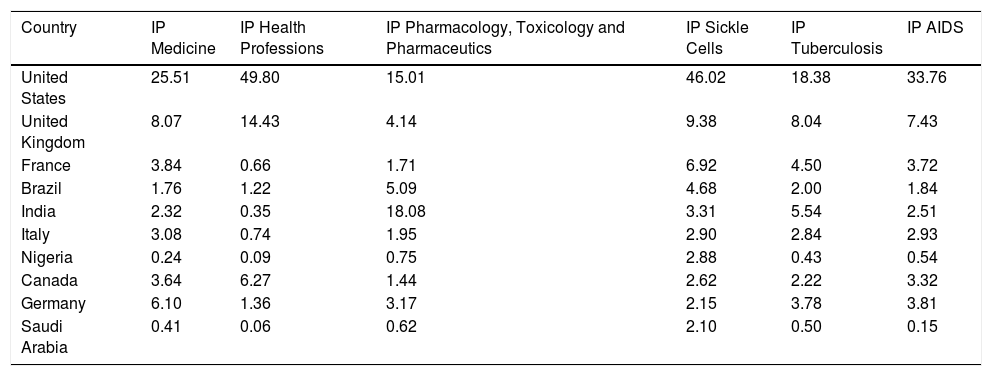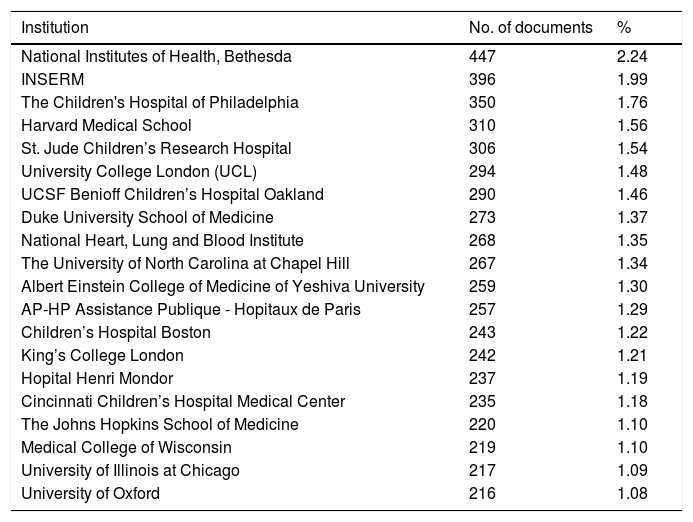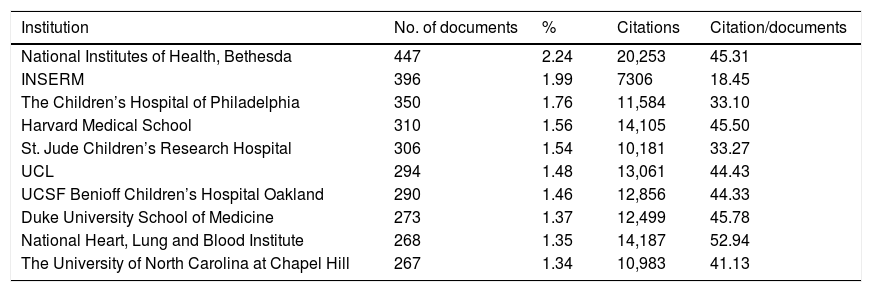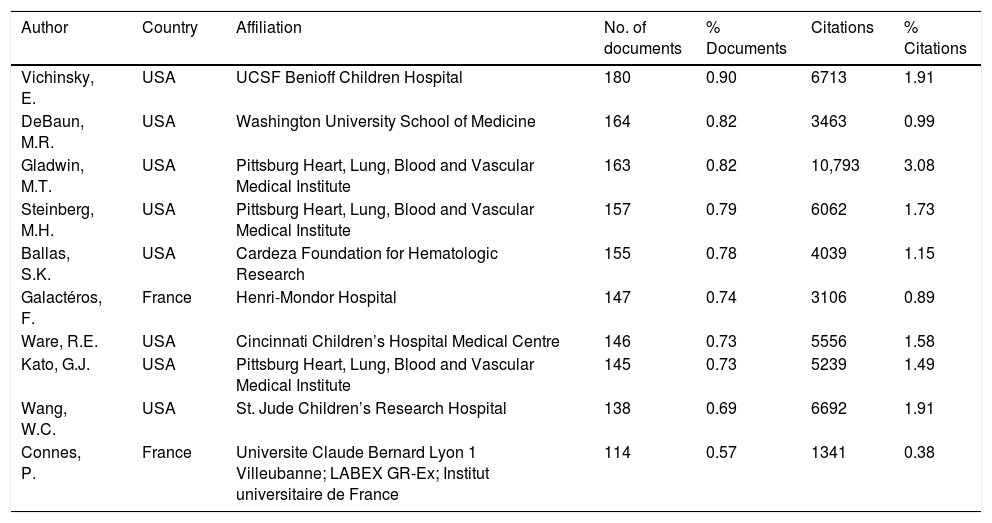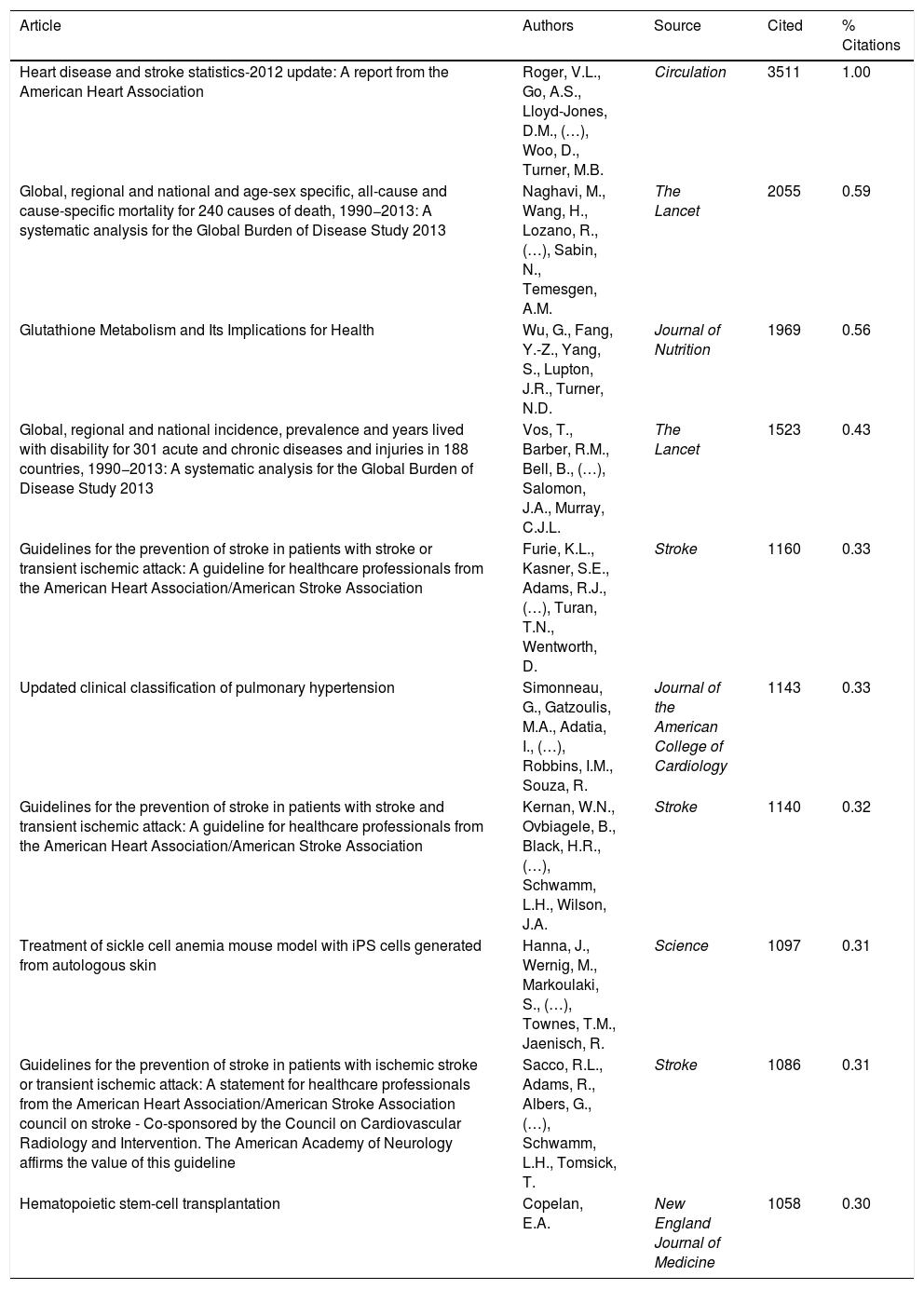Sickle cell disease is an autosomal recessive genetic disease caused by a single point mutation in the β-globin chain of the hemoglobin. It has been recognized by the World Health Organization as a public health priority since 2006.
MethodsThe Scopus database was used in this study with the search descriptors: “sickle cell” and “sickle cell disease”. We applied common bibliometric indicators to evaluate the trend in scientific literature in sickle cell disease research.
ResultsWe retrieved a total of 19,921 pieces of scientific literature in the repertoire from 1997 to 2017. The Price law was fulfilled in the trend of production of scientific literature on SCD as the growth of scientific literature was more exponential (r=0.9751; r2=0.9509) than linear (r=0.9721; r2=0.9449). We observed a duplication time of 4.52 years. The Bradford core was made up of 69 journals with Blood at the top, publishing the greatest number of articles. The most productive institutions were mostly United States agencies and hospitals. The United States was the most productive country. The National Institute of Health was the most productive institution and also had the highest number of citations. Vichinsky E was the most productive author, while the most cited article was published by Circulation.
ConclusionThe growth of scientific literature in Sickle cell disease was found to be high. However, the exponential growth trend shows a “yet-to-be-explored” area of research. This study will be useful for physicians, researchers, research funders and policy-cum-decision makers.
Sickle cell disease (SCD) was first identified in 1910 by James Herrick,1 followed by the description of the molecular basis of the disease in 1949 by Linus Pauling and colleagues.2–4 It is an autosomal recessive genetic disease cause by a single point mutation (69 A>T) in the β-globin chain of the hemoglobin in which there is substitution of hydrophobic valine residue for negatively charged glutamic acid residue, consequently resulting in non-covalent polymerization and double strand formation under low oxygen.3,5 This non-covalent polymerization of the sickle hemoglobin into long fibers under oxygen tension (deoxygenation) is the major pathological event in SCD. The resulting fibers distort red blood cells into atypical and heterogeneous shapes; crescent (classical sickle), elongated, granular and oval shapes6–8 that lack deformability. These red cells with decreased deformability (loss of membrane elasticity) are rigid and sticky and are usually trapped in narrow capillary blood vessels causing frequent episodes of vaso-occlusion and ischemia.6,9 In addition, the stiff cells that are unable to return to the normal shape are spotted and destroyed via hemolysis.9,10 The SCD encompasses sickle cell anemia (which is the inheritance of two S genes), and co-inheritance of hemoglobin C (HbSC) or β-thalassaemia (HbS/β-thalassaemia). However, sickle cell anemia is the most prevalent globally, accounting for an estimated 83% of all newborns with SCD.11 Conversely, those who inherit a single HbS gene, together with HbA (heterozygotes), are carriers and usually asymptomatic.
The World Health Organization recognized sickle cell anemia as a public health priority in 2006, and subsequently adopted a resolution on the prevention and management of birth defects, including sickle cell disease and thalassemia at the 63rd (2010) World Health Assembly.12–14 The prevalence of sickle cell disease depends on the sickle cell trait, which is now widespread, reaching its highest prevalence in parts of Africa, the Mediterranean Basin and Saudi Arabia. In countries such as Ghana, Cameroon, Nigeria, Gabon and Republic of Congo, the prevalence is between 20% and 30%, while in some parts of Uganda, it is as high as 45%. In countries where the trait is above 20%, the disease affects about 2% of the population.15 On a global map of HbS allele frequency distribution with Bayesian geostatistical model using a database of sickle hemoglobin surveys by Piel et al.,16 it was shown that 50% of the total AS and SS neonates were born in only three countries, namely, Nigeria, India and the Democratic Republic of Congo. Nigeria has the highest incidence of SCD in the world, with approximately 91,011 children born with the defect, accounting for approximately 2% of all newborns annually, followed by the Democratic Republic of Congo, with 39,743 sickle cell births per year.17
“Bibliometrics” is a term coined by Allan Pritchad to define the use of mathematical-cum-statistical procedures to the process of the propagation of written communication in the field of scientific discipline through the quantitative study of the varying aspects of this type of communication.18,19 Bibliometric studies are relevant tools in social and scientific evaluation of a given discipline within a specified time frame. Bibliometric indicators are proxy markers for activity in a field of research.20,21
This study aimed at identify the trend in sickle cell disease, as well as to analyze the structure of the evolving sickle cell disease research community network over time. The result of this study will be relevant to clinicians, researchers and government/health policymakers, as well as research finders.
MethodsData sourceThe Scopus database was used for this bibliometric study, considering that it is the largest abstract and citation database of peer reviewed literature. It indexes approximately 22,000 journal titles from over 5000 publishers. Among these, approximately 20,000 are peer-reviewed journals across the scientific, medical, technical and social science disciplines. In comparison with other bibliometric databases, Scopus is better suited to the biomedical field, as it is comprehensive and user-friendly, coupled with the fact that it largely regarded as the world’s largest database for abstract and citation information, and is conveniently used in many bibliometric studies.22,23 We used the remote downloading technique to retrieve articles published from 1997 to 2017 containing the descriptors “sickle cell” and “sickle cell disease”, limited to three fields, namely, title, keyword, and/or abstract. We included all original articles, reviews, editorials, brief reports letters to editors and so forth.
Bibliometric indicatorsThe bibliometric indicators used in this study are similar to those used in our previous bibliometric studies19,24 and they include Price’s law, duplication time and annual growth rate, Bradford zones, bibliometric coupling and key word analysis.
We employed Price’s law25 as an indicator of productivity, as it is the most common bibliometric indicator for assessing productivity within a specific discipline or country. The Price law uses exponential growth evaluation. To assess if scientific production in sickle cell disease follows Price’s law of exponential growth, we modeled our generated data into a linear adjustment, utilizing the equation y=50.904x – 101216, and implemented another adjustment to an exponential curve, using the equation y=3E – 46e0.0557x. The Price law is fulfilled when the coefficient of determination of the exponential curve is greater than that of the linear curve.
The duplication time and annual growth rate were also utilized in this study as bibliometric indicators. The duplication time refers to the time (in years) it takes for a subject to double its production. Conversely, annual growth rate conveys information on the present growth in relation to the preceding year and is denoted in percentage. The duplication time was calculated using the formula:
where b represents the constant that relates the growth rate with the already acquired output of the discipline. The annual growth rate was calculated using the formula:
R=100 (eb – 1)
Bradford’s law26 was utilized to determine the dispersion of scientific literature. Bradford created concentric zones of productivity, referred to as Bradford zones, with decreasing density of information. He hypothesized that each zone contains a similar number of documents, whereas the number of journals in which they are produced increases as one moves from one zone to the next. The division of journals in the different Bradford zones is as follows: 1, n, n2 … The number of articles are divided into 3 groups of approximately the same size, in which one is the core zone, while the other two are peripheral zones. This stratification aids in identifying the most widely used and highest impact journals in a specific area of interest/evaluation.
The Impact Factor (IF) was used as a measure of the journal’s influence and it was originally developed by the Institute for Science Information (Philadelphia, PA, USA) as a bibliometric indicator and was updated annually in the Journal Citation Report (JCR) section of Science Citation Index Expanded (SCI). The calculation contemplates the number of times a given journal is cited by SCI journals within the two preceding years. The value is usually a marker of scientific “prestige”. We used the JCR 2018 impact factor data for this study.
The National Participation Index (PaI) was evaluated for the overall 1997–2017 scientific publication on sickle cell disease and in the fields of medicine and other medical-cum-health-related-disciplines in the world’s ten most productive countries in sickle cell disease research. It is the number of documents on the topic in question (in this case, sickle cell), compared to the global participation index in biomedicine and in a broader scope of sciences and other subareas and medical and health sciences. We further correlated the participation index with health data, such as per capita expenditure on health, as well as the country’s gross domestic expenditure on research, with the 2015 data obtained from the World Bank27 and World Health Organization Department of Health Statistics.28
We also used bibliometric coupling to assess the trend of interest of various institutions involved in sickle cell disease research.
Key words analysis was used to evaluate the trend of discussion and research, with respect to disease characteristics, clinical research, pathology and treatment and effect.
ResultsAssessment of global publicationA total of 19,921 research publications were recovered using the search criteria within the study period of 1997 to 2017. Of these, 63.72% (n=12,693) were original articles, while 17.35% (n=3,457), 5.87% (n=1,170), 3.21% (n=639), 2.79% (n=555), 2.41% (n=480), 2.15% (n=429), 1.52% (n=302), 0.47% (n=94), 0.36% (n=72), 0.13% (n=25) and 0.03% (n=5) were reviews, letters, notes, conference papers, editorials, book chapters, short surveys, errata, articles in press, books and conference reviews, respectively (Table 1).
As shown in Fig. 1, there has been a remarkable increase in the number of scientific publications in the field of sickle cell disease research over the 20-year period. The linear and exponential adjustments, as per Fig. 1, yielded the correlation coefficients r of 0.9721 (R2=0.9449) and 0.9751 (R2=0.9509), respectively. This shows that the growth of scientific publication on SCD is in the exponential growth stage (as r for the exponential curve is >r for the linear curve), with an average annual increase of 4.93%. It is worthy of note that only 4.1% of the data is not explained by the equation.
Fig. 2 shows the temporal production of scientific literature. To calculate the duplication time, the trend line was fitted to the equation y=1129.2e0.152x with the correlation coefficient 0.9590 (R2=0.9197) over the 29-year timeframe. Applying the equation for duplication times rendered a duplication time of 4.52 years. This means that the production of scientific publications doubles every 4.52 years.
Fig. 3 shows that the global production of scientific literature on SCD stratified into five-year periods. It was observed that in each 5-year period, there is a gradual increase over the previous one. It was observed that the 2013–2017 period contained the majority of the documents, accounting for 36.41% of the total documents.
Table 2 shows the distribution of the journals in the Bradford zones. A total of 4103 different journals published the articles under study. However, only 13.67% of them were responsible for more than 60% (66.36%) of the published manuscripts. The core Bradford zones (those containing the largest number of articles) consisted of 69 journals; notably Blood, American Journal of Hematology, British Journal of Haematology, and others.
Analysis of sources with highest publicationTable 3 shows the analysis of sources with the largest number of publications on SCD research represented by the top 10 journals on the list, with their corresponding impact factors, according to JCR 2018, and their productivity index in the total database within the study period. Seven (7) and 4 of the journals have impact factors greater than 2 and 5, respectively. The top ten most productive journals were: Blood, American Journal of Hematology, British Journal of Haematology, Pediatric Blood and Cancer, Journal of Pediatric Hematology and Oncology, Hemoglobin, Revista Brasileira de Hematologia e Hemoterapia, Transfusion, Haematologica and PLoS ONE.
Analysis of sources with the highest number of publicationsa.
| No. of documents | Productivity Index | Impact Factor | Country of origin | Abbreviated Journal Title | |
|---|---|---|---|---|---|
| Blood | 642 | 3.22 | 15.132 | USA | Blood |
| American Journal of Hematology | 525 | 2.64 | 5.303 | USA | Am. J. Hematol. |
| British Journal of Haematology | 458 | 2.30 | 5.128 | England | Br. J. Haematol. |
| Pediatric Blood and Cancer | 360 | 1.81 | 2.642 | USA | Pediatr. Blood Cancer |
| Journal of Pediatric Hematology/Oncologyb | 243 | 1.22 | 1.060 | Switzerland | Int. J. Pediatr. Hematol-Oncol. |
| Hemoglobin | 239 | 1.20 | 0.462 | USA | Hemoglobin |
| Revista Brasileira de Hematologia e Hemoterapyc | 193 | 0.97 | 0.62 | Brasil | Rev. Bras. Hematol. Hemoter. |
| Transfusion | 183 | 0.92 | 3.432 | USA | Transfusion |
| Haematologica | 182 | 0.91 | 9.090 | Italy | Haematologica |
| PLoS ONE | 168 | 0.84 | 2.766 | USA | PLoS One |
Table 4 shows the top 20 most productive countries in SCD research, the United States (n=9167) and the United Kingdom (n=1869) having the participation index (PI) of 46.02 and 9.38, respectively. Next on the list are France (n=1379; PI=6.92) Brazil (n=933; PI=4.68), India (n=660; PI=3.31), Italy (n=577; PI=2.90), Nigeria (n=574; PI=2.88), and Canada (n=522; PI=2.62). It is pertinent to note the United States alone accounted for nearly half (46.02%) of all publications.
Top 20 most productive countries.
| Country | No. of documents | % |
|---|---|---|
| United States | 9167 | 46.02 |
| United Kingdom | 1869 | 9.38 |
| France | 1379 | 6.92 |
| Brazil | 933 | 4.68 |
| India | 660 | 3.31 |
| Italy | 577 | 2.90 |
| Nigeria | 574 | 2.88 |
| Canada | 522 | 2.62 |
| Germany | 429 | 2.15 |
| Saudi Arabia | 418 | 2.10 |
| Netherlands | 375 | 1.88 |
| Turkey | 307 | 1.54 |
| Jamaica | 232 | 1.16 |
| Greece | 216 | 1.08 |
| Spain | 215 | 1.08 |
| Belgium | 205 | 1.03 |
| Australia | 203 | 1.02 |
| Switzerland | 175 | 0.88 |
| Egypt | 150 | 0.75 |
| Israel | 140 | 0.70 |
The comparative analysis of the productivity of the top 10 most productive countries in sickle cell research with their overall production in medicine showed that only 7 out of the 10 countries (United Kingdom, USA, France, Brazil, India, Nigeria and Saudi Arabia) devoted a higher proportion of attention to the study of SCD, in relation to medicine in general. The United States, the United Kingdom and France were consistently leading both in sickle cell disease research and research in medicine in general (Table 5).
Comparative analysis of the productivity of the top 10 most productive countries in SCD research, with their overall production in medicine and other areas of biomedical research.
| Country | IP Medicine | IP Health Professions | IP Pharmacology, Toxicology and Pharmaceutics | IP Sickle Cells | IP Tuberculosis | IP AIDS |
|---|---|---|---|---|---|---|
| United States | 25.51 | 49.80 | 15.01 | 46.02 | 18.38 | 33.76 |
| United Kingdom | 8.07 | 14.43 | 4.14 | 9.38 | 8.04 | 7.43 |
| France | 3.84 | 0.66 | 1.71 | 6.92 | 4.50 | 3.72 |
| Brazil | 1.76 | 1.22 | 5.09 | 4.68 | 2.00 | 1.84 |
| India | 2.32 | 0.35 | 18.08 | 3.31 | 5.54 | 2.51 |
| Italy | 3.08 | 0.74 | 1.95 | 2.90 | 2.84 | 2.93 |
| Nigeria | 0.24 | 0.09 | 0.75 | 2.88 | 0.43 | 0.54 |
| Canada | 3.64 | 6.27 | 1.44 | 2.62 | 2.22 | 3.32 |
| Germany | 6.10 | 1.36 | 3.17 | 2.15 | 3.78 | 3.81 |
| Saudi Arabia | 0.41 | 0.06 | 0.62 | 2.10 | 0.50 | 0.15 |
Fig. 4 shows the correlation between the production of scientific literature on SCD and current health expenditure (CHE) and gross domestic expenditure on research in the 15 most productive countries in SCD research. In the analysis of the correlation between the participation index and the current health expenditure of each of the top 15 most productive countries in SCD, the trend obtained was inconsistent, except for the United States and France, that maintained their trend. In addition, the correlation between the 15 top producers and the gross domestic expenditure on research also showed an inconsistent pattern, except for France.
The topmost productive institutions in SCD research are represented in Table 8. The National Institute of Health, Bethesda was the most productive institution (n=447; 2.24%), followed by INSERM (n=396; 1.99%), the Children’s Hospital of Philadelphia (n=350; 1.76%), Harvard Medical School (n=310; 1.56%), St. Jude Children’s Research Hospital (n=306; 1.54%) and others.
Seventy percent (70%) of the top 20 most productive institutions are located in the United States, whereas the rest are in France (15%), and the UK (15%). Five (25%) of the topmost productive institutions are public universities, while 5 (25%), 4 (20%), 3 (15%), 2 (10%) and 1 (5%) are private universities/medical colleges, not-for-profit hospitals, government agencies, public hospitals and a private hospital, respectively (Table 6).
Top 20 most productive institutions.
| Institution | No. of documents | % |
|---|---|---|
| National Institutes of Health, Bethesda | 447 | 2.24 |
| INSERM | 396 | 1.99 |
| The Children's Hospital of Philadelphia | 350 | 1.76 |
| Harvard Medical School | 310 | 1.56 |
| St. Jude Children’s Research Hospital | 306 | 1.54 |
| University College London (UCL) | 294 | 1.48 |
| UCSF Benioff Children’s Hospital Oakland | 290 | 1.46 |
| Duke University School of Medicine | 273 | 1.37 |
| National Heart, Lung and Blood Institute | 268 | 1.35 |
| The University of North Carolina at Chapel Hill | 267 | 1.34 |
| Albert Einstein College of Medicine of Yeshiva University | 259 | 1.30 |
| AP-HP Assistance Publique - Hopitaux de Paris | 257 | 1.29 |
| Children’s Hospital Boston | 243 | 1.22 |
| King’s College London | 242 | 1.21 |
| Hopital Henri Mondor | 237 | 1.19 |
| Cincinnati Children’s Hospital Medical Center | 235 | 1.18 |
| The Johns Hopkins School of Medicine | 220 | 1.10 |
| Medical College of Wisconsin | 219 | 1.10 |
| University of Illinois at Chicago | 217 | 1.09 |
| University of Oxford | 216 | 1.08 |
Citation analysis of the topmost productive institutions showed the highest citation for the National Institute of Health, Bethesda and the National Health, Lung and Blood Institute, while the highest citation per document was recorded at the National Heart, Lung and Blood Institute and Duke University School of Medicine (Table 7).
Citation analysis of the 10 topmost productive institutions.
| Institution | No. of documents | % | Citations | Citation/documents |
|---|---|---|---|---|
| National Institutes of Health, Bethesda | 447 | 2.24 | 20,253 | 45.31 |
| INSERM | 396 | 1.99 | 7306 | 18.45 |
| The Children’s Hospital of Philadelphia | 350 | 1.76 | 11,584 | 33.10 |
| Harvard Medical School | 310 | 1.56 | 14,105 | 45.50 |
| St. Jude Children’s Research Hospital | 306 | 1.54 | 10,181 | 33.27 |
| UCL | 294 | 1.48 | 13,061 | 44.43 |
| UCSF Benioff Children’s Hospital Oakland | 290 | 1.46 | 12,856 | 44.33 |
| Duke University School of Medicine | 273 | 1.37 | 12,499 | 45.78 |
| National Heart, Lung and Blood Institute | 268 | 1.35 | 14,187 | 52.94 |
| The University of North Carolina at Chapel Hill | 267 | 1.34 | 10,983 | 41.13 |
Ten most productive authors in SCD research.
| Author | Country | Affiliation | No. of documents | % Documents | Citations | % Citations |
|---|---|---|---|---|---|---|
| Vichinsky, E. | USA | UCSF Benioff Children Hospital | 180 | 0.90 | 6713 | 1.91 |
| DeBaun, M.R. | USA | Washington University School of Medicine | 164 | 0.82 | 3463 | 0.99 |
| Gladwin, M.T. | USA | Pittsburg Heart, Lung, Blood and Vascular Medical Institute | 163 | 0.82 | 10,793 | 3.08 |
| Steinberg, M.H. | USA | Pittsburg Heart, Lung, Blood and Vascular Medical Institute | 157 | 0.79 | 6062 | 1.73 |
| Ballas, S.K. | USA | Cardeza Foundation for Hematologic Research | 155 | 0.78 | 4039 | 1.15 |
| Galactéros, F. | France | Henri-Mondor Hospital | 147 | 0.74 | 3106 | 0.89 |
| Ware, R.E. | USA | Cincinnati Children’s Hospital Medical Centre | 146 | 0.73 | 5556 | 1.58 |
| Kato, G.J. | USA | Pittsburg Heart, Lung, Blood and Vascular Medical Institute | 145 | 0.73 | 5239 | 1.49 |
| Wang, W.C. | USA | St. Jude Children’s Research Hospital | 138 | 0.69 | 6692 | 1.91 |
| Connes, P. | France | Universite Claude Bernard Lyon 1 Villeubanne; LABEX GR-Ex; Institut universitaire de France | 114 | 0.57 | 1341 | 0.38 |
Fig. 5 shows the bibliometric coupling among the most productive institutions in SCD research.
Productivity of authorsTable 8 shows the analysis of the top 10 most productive authors in SCD research. Vichinsky E, DeBaun MR, Gladwin MT, Steinberg MH, Ballas SK, Galacteros F, Ware RE, Kato GJ, Wang WC and Connes P were the top 10 productive authors. Eight (8) out of the 10 of the most productive authors are resident in the United States and are affiliated with the UCSF Benioff Children’s Hospital, Washington School of Medicine, Pittsburg Heart, Lung, Blood and Vascular Medicine Institute, Thomas Jefferson University, Cincinnati Children’s Medical Centre and St. Jude Children’s Research Hospital. The other two authors are affiliated with the Henri-Mondor Hospital and Institute Universitaire de France/Universite Claude Bernard Lyon 1 Villeubanne/Laboritoire d’Excellence du Globule Rouge in France.
Citation analysis of articlesTable 9 shows the top 10 most cited articles. The most cited article was an update report dedicated on heart disease and stroke, while the second was dedicated to causes of mortality (SCD inclusive). The third top cited article was dedicated to the glutathione metabolism, with mention of how oxidative stress plays a critical role in the pathogenesis of sickle cell disease. Only the eighth top article was dedicated to the treatment of SCD using a mouse model.
Top 10 most cited articles in SCD research.
| Article | Authors | Source | Cited | % Citations |
|---|---|---|---|---|
| Heart disease and stroke statistics-2012 update: A report from the American Heart Association | Roger, V.L., Go, A.S., Lloyd-Jones, D.M., (…), Woo, D., Turner, M.B. | Circulation | 3511 | 1.00 |
| Global, regional and national and age-sex specific, all-cause and cause-specific mortality for 240 causes of death, 1990−2013: A systematic analysis for the Global Burden of Disease Study 2013 | Naghavi, M., Wang, H., Lozano, R., (…), Sabin, N., Temesgen, A.M. | The Lancet | 2055 | 0.59 |
| Glutathione Metabolism and Its Implications for Health | Wu, G., Fang, Y.-Z., Yang, S., Lupton, J.R., Turner, N.D. | Journal of Nutrition | 1969 | 0.56 |
| Global, regional and national incidence, prevalence and years lived with disability for 301 acute and chronic diseases and injuries in 188 countries, 1990−2013: A systematic analysis for the Global Burden of Disease Study 2013 | Vos, T., Barber, R.M., Bell, B., (…), Salomon, J.A., Murray, C.J.L. | The Lancet | 1523 | 0.43 |
| Guidelines for the prevention of stroke in patients with stroke or transient ischemic attack: A guideline for healthcare professionals from the American Heart Association/American Stroke Association | Furie, K.L., Kasner, S.E., Adams, R.J., (…), Turan, T.N., Wentworth, D. | Stroke | 1160 | 0.33 |
| Updated clinical classification of pulmonary hypertension | Simonneau, G., Gatzoulis, M.A., Adatia, I., (…), Robbins, I.M., Souza, R. | Journal of the American College of Cardiology | 1143 | 0.33 |
| Guidelines for the prevention of stroke in patients with stroke and transient ischemic attack: A guideline for healthcare professionals from the American Heart Association/American Stroke Association | Kernan, W.N., Ovbiagele, B., Black, H.R., (…), Schwamm, L.H., Wilson, J.A. | Stroke | 1140 | 0.32 |
| Treatment of sickle cell anemia mouse model with iPS cells generated from autologous skin | Hanna, J., Wernig, M., Markoulaki, S., (…), Townes, T.M., Jaenisch, R. | Science | 1097 | 0.31 |
| Guidelines for the prevention of stroke in patients with ischemic stroke or transient ischemic attack: A statement for healthcare professionals from the American Heart Association/American Stroke Association council on stroke - Co-sponsored by the Council on Cardiovascular Radiology and Intervention. The American Academy of Neurology affirms the value of this guideline | Sacco, R.L., Adams, R., Albers, G., (…), Schwamm, L.H., Tomsick, T. | Stroke | 1086 | 0.31 |
| Hematopoietic stem-cell transplantation | Copelan, E.A. | New England Journal of Medicine | 1058 | 0.30 |
We identified 160 keywords in the search repertoire. Stratification of the keywords into 4 clusters (“characteristics”, “clinical research”, “pathogenesis” and “Treatment and effect”) showed that “characteristics” comprised 24.3%, while “clinical research”, “pathogenesis” and “treatment and effect” comprised 26.5%, 40.0% and 9.4%, respectively. Under “characteristics”, “human” was the most commonly used keyword, while “hydroxyurea” and “blood transfusion” were the commonly used keywords under “treatment and effect”. “Controlled study” was the most commonly used keyword under “clinical research”, while “anemia” was the most commonly used keyword under “pathogenesis” (Fig. 6).
DiscussionThe most utilized document type in this study by authors is original article, which accounted for about 63.72% of all article types used. This reflects the fact that the subject matter refers to experiments or clinical research.
We observed an exponential growth trend in publications related to SCD research in the past 20 years, with an average annual increase of 4.93%, without evidence of reaching saturation, as postulated by Price’s law, hence fulfilling Price’s law. This significant growth in the field of SCD research leads us to the conclusion that the field of SCD is still at the prime of development, from the clinical and basic research perspectives. This immense growth in the research output can be attributed to the continual interest in research geared towards providing curative and disease-modifying agents for SCD. There have been immense efforts made in diverse clinical trials on stem cell replacement/modification, antisickling agents, gene therapy, antioxidant therapy and other anti-adhesive therapies.29 The observed trend is similar to previous reports in areas of optometry, bipolar disorder and obstetrics and gynecology.24,30,31 However, the trend is at variance with a linear trend observed in a study on an infectious disease (Lassa fever).19
Bradford stratification of the articles showed that only 19 journals (1.68%) were responsible for the production of 33.49% of the published literature. This trend reflects a high concentration of publications by a small group of journals. Individual analysis showed that Blood had the highest number of publications, accounting for approximately 3.22% of all publications, followed by American Journal of Hematology (2.64%) and British Journal of Haematology. All the top ten journals were dedicated to hematology except PLoS ONE, that is a multi-disciplinary journal.
Country-wise analysis of research output on sickle cell disease showed that the United States, the United Kingdom and France topped the research output in SCD research and accounted for 62.32% of the total research output on sickle cell disease. The United States alone accounted for 46.02% of the total research output. The reason for this increased productivity cannot be far-fetched, as the US, the UK and France housed the most productive institutions, research institutes, hospitals and universities. Moreover, the trio is home to major pharmaceutical companies that manufacture the disease-modifying drug hydroxyurea approved for the management of SCD: Droxia®, Hydrea®, and Litalir® by Bristol-Myers Squibb Co, USA, France, Italy, India, China, England, Belgium and Siklos®, by Addmedica, France. India is also home to the brands of hydroxyurea: Ribore (Khandelwal Laboratory Pvt Ltd), Readrox (Miracalus Pharma Pvt Ltd), Neodrea (Vhb Life Science Inc.) and Myelostat (Zydus Cardila), while Italy, in addition to Bristol-Myers Squibb Co, houses Teofarma Srl, that manufactures Oncocarbide™. In addition, the United States is the home of Emmaus Medical Inc., the pharmaceutical company that manufactures the newly approved disease-modifying drug, Endari, for SCD. It is noteworthy that Nigeria, documented as having the highest incidence of sickle cell disease in the world, was the only African country present in the top 20 most productive countries. Hence, the endemicity of the disease could serve as a boost in the interest in studying the disease. Additionally, Nigeria houses the pharmaceutical company Bond Chemical Pvt Ltd, that manufactures the brand of hydroxyurea, Oxyurea. While comparing the most productive countries in SCD research to research in general medicine and some other infectious diseases, the striking interest of Brazil, France, Nigeria and Saudi Arabia was remarkable. However, it is noteworthy that Brazil (South America), France (Europe) and Nigeria (Africa) retain the highest sickle cell disease burden in their continents.17,32,33 This could partly explain the seeming research interest of the duo of Brazil and Nigeria in sickle cell disease research (in relation to other medical research) amidst their limited resources, as compared to other economically advanced countries on the list, such as France. Moreover, the low comparative participation index of Germany in SCD research, in relation to general research in medicine, was also remarkable.
A comparative analysis between the production in SCD and current health expenditure showed that the higher the current health expenditure is, the greater the productivity in research in SCD becomes, with some exceptions: France, Italy, Canada, Germany, Saudi Arabia, Netherlands, Turkey, Jamaica, Greece and Spain, in which the current health expenditure exceeded their participation index in SDC research. However, Nigeria had the lowest current health expenditure (3.57% of the GDP).
The correlation analysis of the comparison between scientific productivity in SCD and gross domestic expenditure on research and development (R&D) placed Jamaica, Nigeria and India in the last three positions in the evaluated countries. It is noteworthy that only 2 of the most productive countries in SCD research (Germany; 2.88% and the US; 2.79%) had a gross expenditure on R&D above the Organization for Economic Cooperation and Development (OECD) average of 2.3%, while only 4 (Germany; 2.88%, the US; 2.79%, France; 2.23% and Netherlands) had a gross expenditure on R&D above the EU-28 average of 1.9%. The scientific output of a country is a reflection of its earlier investment in research and development in the years preceding the year of analysis and not as a result of a particular economic event in the evaluation period.30,34
Institutions in the United States dominated the list of the top 20 most productive institutions, followed by France and the United Kingdom. This further explains why the United States occupied the top in productivity in SCD research. This finding implies that the creation of first-class research institutes is fundamental in the improvement in research and academic output of a country. The National Institute of Health is a part of the United States Department of Health and Human Services that serves as the nation’s medical agency. It conducts its own research via its Intramural Research Program, as well as provides major biomedical research funding to external research facilities via its Extramural Research Program.35 On the other hand, the Institut National de la saite et la Recherche Medicale (INSERM) is the French national institute of health and medical research dedicated to human health, having the objective of promoting health by advancing knowledge about life and disease and treatment innovation in public health research.36
Unlike cocitation analysis, which is a measure of the frequency with which two documents are cited together by one document,37 bibliometric coupling occurs when two different studies reference a common third study in their bibliography.38,39 Bibliographic coupling shows similarity of the subject matter of the two publications. In this study, we observed the existence of several groups of institutions bibliographically coupled, forming a huge bibliographic network. For instance, the National Heart, Lung and Blood Institute, St. Jude Children’s Research Hospital, Children’s Hospital Boston and Johns Hopkins School of Medicine can be tagged as premium networks of the American Institutions. Another group of American institutions that are bibliographically coupled are: the Harvard Medical School, Medical College of Wisconsin and Cincinnati Children’s Hospital Medical Center. Among the European institutions bibliometrically coupled are: the INSERM, University College London. The citing of papers in common at these Institutions reflects a voluminous bibliometric network showing research focused on related topics.
Vichinsky E, DeBaun MR, Gladwin MT, Steinberg MH, Ballas SK, Galacteros F, Ware RE, Kato GJ, Wang WC and Connes P were the top 10 productive authors. Vichinsky E. focused on treatment, pathogenesis and population-based survey, especially on chronic organ failure in sickle cell disease.40,41 DeBaun MR focused on pathogenesis and treatment and effect in SCD,42,43 while Gladwin MT, Steinberg MH, Ballas SK and Galacteros F dedicated most of their studies to the treatment/outcome and pathophysiology of SCD. These authors have published several novel works and are likely to have a tremendous impact on the future development in SCD research.
The core journals utilized in the publication of SCD research were Blood, American Journal of Hematology, British Journal of Haematology, Pediatric Blood and Cancer, Journal of Pediatric Hematology/Oncology, Hemoglobin, Revista Brazileira de Hematologia e Homoterapia, Transfusion, Haematologica and PLoS ONE. Subsequently, researchers may pay attention to these journals as future breakthroughs in SCD are more likely to be published in these journals.
The article “Heart disease and stroke statistics-2012 updates”, a report from American Heart Association published by Circulation, was the most cited article, accounting for 1% of the total citation. It was an article dedicated to statistics, risk factors and economic costs of heart diseases and stroke. The second most cited article was an article on glutathione and its implications in varying health conditions, including sickle cell. The eighth most cited article, “Treatment of sickle cell anemia mouse model with iPS cells generated from autologous skin”,44 published by Science, was the only article among the top 10 articles dedicated solely to sickle cell disease research. Two of the journals (New England of Medicine and Science) are delayed open access, while the remaining 8 are hybrid journals. These journals are all well established journals, with impact factors greater than 4.
The analysis of keywords is an important bibliometric tool used in monitoring and discovering directions and popular topics in research.45,46 In the present study, there is a shift in terms of research focus from “characteristics” to “pathogenesis” and “clinical research”. The cluster of treatment and effect was still low. This suggests a non-saturated research in treatment options “begging” for more research. The rule of translational medicine is usually the movement from disease characteristics to treatment.47 The only disease modifying therapies approved for SCD are hydroxyurea, approved in 1997, and L-glutamate, approved two decades afterward (2017). There have been promising studies on antisickling agents, as well as on gene therapy. Allogenic hematopoietic stem cell transplant and gene therapy are the only curative treatments, showing promising results.29 The key advantage of gene therapy over hematopoietic stem cell transplant is the option to use autologous stem cells, thereby precluding the need to screen donors. In the cluster of “characteristics”, “human” was the most commonly used keyword, while “controlled study” was the most commonly used keyword in the cluster of “clinical research”. “Anemia” was the most commonly used keyword under the “pathogenesis” cluster, while “hydroxyurea” was the most commonly used keyword under the “treatment and effect” cluster.
However, there are some limitations to this study, which are mainly inherent in bibliometric studies. The Scopus database was used for this study, hence, local journals that were not indexed in Scopus during the study period were not included. We might have excluded articles on sickle cell if the authors did not include our search descriptors in the title, abstract or keyword. Moreover, the criteria mapped out by the database themselves determine the subsequent development of the studied material.48
ConclusionDespite the inherent limitations outlined, we believe that this study has provided a significant representation of the global research trend in sickle cell disease research. This study showed that research in SCD is still in the exponential stage. Considering the lag in treatment and effect amidst the exponential growth, it is a pointer that research in SCD will most probably increase in growth in proceeding years, while bearing in mind that the curative approach to SCD is still at the clinical trial stage. A substantial number of the research publications was from high-income countries, including the US, the UK and France.
Author contributionsHUO conceived the study, analyzed data, performed the literature search and prepared the manuscript; FLM performed database analysis and data curation, analyzed data and performed the initial editing of the manuscript; FJP performed database analysis and data curation, analyzed data and performed the initial editing of the manuscript. All authors read and approved the final manuscript.
Conflicts of interestThe authors declare no conflicts of interest.









